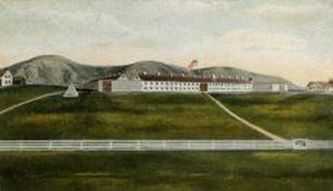History: The Second Fort Crawford
 The second Fort Crawford, as painted by A. Brower.
The second Fort Crawford, as painted by A. Brower.
In the spring of 1829, troops began to build a new Fort Crawford on an elevated plain located on the mainland, safe from the floods that had plagued the first fort. The new structure was built primarily with quarried limestone, and work progressed slowly. Col. Zachary Taylor took command of the construction in the summer of 1829, and Jefferson Davis, a lieutenant at Fort Crawford, supervised work at a sawmill on the Yellow River that provided lumber for construction. Troops moved into the new barracks in December 1830, but the stone fort remained unfinished until 1834.
As the new fort was being built, Dr. William Beaumont remained at the first Fort Crawford to care for ill troops. He also began a set of experiments to study the way food is digested in the stomach. The 56 experiments he performed at Fort Crawford were a founding component of modern knowledge of the digestive system. A restored ward room in the Fort Crawford Museum offers a glimpse of the environment where he worked.
Soldiers at Fort Crawford served in many capacities after moving into the second fort. Most notably, troops took a more violent role to force American Indians west of the Mississippi River in accordance with the policies of President Andrew Jackson. Troops commanded by Col. Zachary Taylor fought in the Black Hawk War in 1832. On August 27 of that year, Black Hawk surrendered at Prairie du Chien and was jailed at the fort. Later, Lt. Jefferson Davis escorted Black Hawk to another prison at St. Louis. The troops at Fort Crawford also worked to build a military road across Wisconsin to connect Fort Crawford with Fort Winnebago in Portage and Fort Howard in Green Bay. Finally, soldiers from Fort Crawford enforced the relocation of the Ho-Chunk from Wisconsin to a reservation in Iowa. "Indian Removal," as the government called it, disrupted lives across the region and transformed Prairie du Chien, leaving Fort Crawford without much of its earlier significance. Soldiers only occupied the fort intermittently after 1849, and the last active troops withdrew from Fort Crawford on June 9, 1856. Five years later, the outbreak of the Civil War would see a new military use for the fort.
As the new fort was being built, Dr. William Beaumont remained at the first Fort Crawford to care for ill troops. He also began a set of experiments to study the way food is digested in the stomach. The 56 experiments he performed at Fort Crawford were a founding component of modern knowledge of the digestive system. A restored ward room in the Fort Crawford Museum offers a glimpse of the environment where he worked.
Soldiers at Fort Crawford served in many capacities after moving into the second fort. Most notably, troops took a more violent role to force American Indians west of the Mississippi River in accordance with the policies of President Andrew Jackson. Troops commanded by Col. Zachary Taylor fought in the Black Hawk War in 1832. On August 27 of that year, Black Hawk surrendered at Prairie du Chien and was jailed at the fort. Later, Lt. Jefferson Davis escorted Black Hawk to another prison at St. Louis. The troops at Fort Crawford also worked to build a military road across Wisconsin to connect Fort Crawford with Fort Winnebago in Portage and Fort Howard in Green Bay. Finally, soldiers from Fort Crawford enforced the relocation of the Ho-Chunk from Wisconsin to a reservation in Iowa. "Indian Removal," as the government called it, disrupted lives across the region and transformed Prairie du Chien, leaving Fort Crawford without much of its earlier significance. Soldiers only occupied the fort intermittently after 1849, and the last active troops withdrew from Fort Crawford on June 9, 1856. Five years later, the outbreak of the Civil War would see a new military use for the fort.
